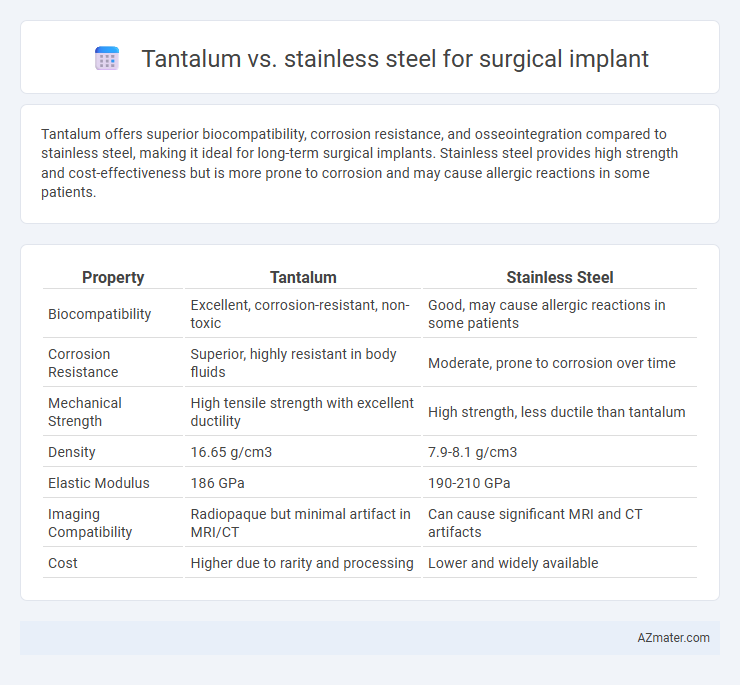Tantalum offers superior biocompatibility, corrosion resistance, and osseointegration compared to stainless steel, making it ideal for long-term surgical implants. Stainless steel provides high strength and cost-effectiveness but is more prone to corrosion and may cause allergic reactions in some patients.
Table of Comparison
| Property | Tantalum | Stainless Steel |
|---|---|---|
| Biocompatibility | Excellent, corrosion-resistant, non-toxic | Good, may cause allergic reactions in some patients |
| Corrosion Resistance | Superior, highly resistant in body fluids | Moderate, prone to corrosion over time |
| Mechanical Strength | High tensile strength with excellent ductility | High strength, less ductile than tantalum |
| Density | 16.65 g/cm3 | 7.9-8.1 g/cm3 |
| Elastic Modulus | 186 GPa | 190-210 GPa |
| Imaging Compatibility | Radiopaque but minimal artifact in MRI/CT | Can cause significant MRI and CT artifacts |
| Cost | Higher due to rarity and processing | Lower and widely available |
Introduction to Surgical Implant Materials
Tantalum and stainless steel are prominent materials in surgical implants due to their biocompatibility and mechanical strength. Tantalum offers superior corrosion resistance and excellent osseointegration, making it ideal for long-term implants, while stainless steel provides cost-effective durability and ease of fabrication. Understanding the distinct properties of these materials guides optimal implant selection for specific surgical applications.
Overview of Tantalum in Medical Applications
Tantalum exhibits exceptional biocompatibility, corrosion resistance, and radiopacity, making it highly suitable for medical implants such as orthopedic and dental devices. Its high density and ability to encourage bone growth provide advantages over stainless steel in specific surgical applications. While stainless steel remains widely used due to cost-effectiveness and strength, tantalum's superior properties lead to enhanced patient outcomes in complex implant procedures.
Properties of Stainless Steel for Implants
Stainless steel used for surgical implants, predominantly 316L grade, exhibits excellent corrosion resistance and mechanical strength essential for load-bearing applications. Its biocompatibility minimizes adverse tissue reactions, while high toughness ensures durability under cyclic stresses in the human body. The alloy's cost-effectiveness and ease of fabrication favor its widespread use despite slightly lower corrosion resistance compared to tantalum.
Biocompatibility: Tantalum vs Stainless Steel
Tantalum demonstrates superior biocompatibility compared to stainless steel, exhibiting excellent corrosion resistance and minimal ion release, which reduces the risk of adverse tissue reactions. Stainless steel, while widely used, can release metallic ions such as nickel and chromium that may cause allergic responses and inflammation in sensitive patients. The inert nature of tantalum's oxide layer promotes better integration with bone tissue, making it more suitable for long-term surgical implants.
Corrosion Resistance in Human Body
Tantalum exhibits superior corrosion resistance compared to stainless steel when used for surgical implants due to its stable and inert oxide film that prevents degradation in the human body's aggressive environment. Stainless steel, while strong and cost-effective, is prone to localized corrosion such as pitting and crevice corrosion caused by chloride ions present in bodily fluids. The exceptional biocompatibility and corrosion resistance of tantalum result in longer implant longevity and reduced risk of inflammation or metal ion release during implantation.
Mechanical Strength and Durability Comparison
Tantalum exhibits superior corrosion resistance and biocompatibility, making it ideal for long-term surgical implants, while stainless steel offers higher tensile strength but is more susceptible to corrosion in physiological environments. The mechanical strength of stainless steel typically ranges from 500 to 1000 MPa, whereas tantalum's lower tensile strength of approximately 170 MPa is offset by its exceptional fatigue resistance and durability in vivo. Implant longevity is enhanced with tantalum due to its stable oxide layer and resistance to pitting, making it preferable in applications where durability under cyclic loading and biological stability are critical.
Imaging Compatibility: MRI and Radiopacity
Tantalum offers superior imaging compatibility for surgical implants due to its excellent MRI safety profile and high radiopacity, enabling clear visualization without significant artifact formation. Stainless steel implants often generate substantial MRI artifacts and magnetic interference, complicating diagnostic imaging. Radiopacity of tantalum facilitates precise postoperative assessment, while stainless steel's lower radiodensity may obscure implant margins on X-rays.
Cost and Availability of Both Materials
Tantalum surgical implants are significantly more expensive than stainless steel due to the rarity and complex extraction process of tantalum, which affects overall treatment costs. Stainless steel remains widely available and cost-effective because of its abundant raw material supply and well-established manufacturing processes. Hospitals and surgeons often prefer stainless steel implants when budget constraints and immediate availability are key considerations in surgical planning.
Clinical Outcomes and Patient Safety
Tantalum exhibits superior biocompatibility and corrosion resistance compared to stainless steel, significantly reducing the risk of implant-related infections and allergic reactions in surgical implants. Clinical outcomes demonstrate tantalum's enhanced osseointegration and mechanical stability, leading to faster healing rates and lower rates of implant failure. Patient safety is improved with tantalum implants due to their inert nature and minimal ion release, which decreases long-term complications often associated with stainless steel implants.
Choosing the Right Material for Surgical Implants
Tantalum offers exceptional biocompatibility, corrosion resistance, and osteointegration, making it ideal for long-term surgical implants, particularly in orthopedic and dental applications. Stainless steel, while cost-effective and providing adequate strength, may pose risks of corrosion and allergic reactions over time, limiting its use in permanent implants. Selecting the appropriate material depends on the implant's function, required longevity, patient sensitivity, and biomechanical demands.

Infographic: Tantalum vs Stainless steel for Surgical implant
 azmater.com
azmater.com